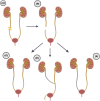Bioengineering solutions for ureteric disorders: clinical need, challenges and opportunities
- PMID: 35388587
- PMCID: PMC9544734
- DOI: 10.1111/bju.15741
Bioengineering solutions for ureteric disorders: clinical need, challenges and opportunities
Abstract
Objectives: To summarise the causes of ureteric damage and the current standard of care, discussing the risks and benefits of available therapeutic options. We then focus on the current and future solutions that can be provided by ureteric bioengineering and provide a description of the ideal characteristics of a bioengineered product.
Methods: We performed a literature search in February 2021 in: Google Scholar, Medline, and Web of Science. Three searches were conducted, investigating: (a) the epidemiology of ureteric pathology, (b) the current standard of care, and (c) the state of the art in ureteric bioengineering.
Results: The most-common causes of ureteric damage are iatrogenic injury and external trauma. Current approaches to treatment include stent placement or surgical reconstruction. Reconstruction can be done using either urological tissue or segments of the gastrointestinal tract. Limitations include scarring, strictures, and infections. Several bioengineered alternatives have been explored in animal studies, with variations in the choice of scaffold material, cellular seeding populations, and pre-implantation processing. Natural grafts and hybrid material appear to be associated with superior outcomes. Furthermore, seeding of the scaffold material with stem cells or differentiated urothelial cells allows for better function compared to acellular scaffolds. Some studies have attempted to pre-implant the graft in the omentum prior to reconstruction, but this has yet to prove any definitive benefits.
Conclusion: There is an unmet clinical need for safer and more effective treatment for ureteric injuries. Urological bioengineering is a promising solution in preclinical studies. However, substantial scientific, logistic, and economic challenges must be addressed to harness its transformative potential in improving outcomes.
Keywords: #UroTrauma; #Urology; Ureteric injury; bioengineered solution; tissue engineering; ureteric reconstruction.
© 2022 The Authors. BJU International published by John Wiley & Sons Ltd on behalf of BJU International.
Conflict of interest statement
The authors declare no conflicts of interest.
Figures




References
-
- Engelsgjerd JS, LaGrange CA. Ureteral Injury. In: StatPearls [Internet]. Treasure Island, FL: StatPearls Publishing, 2020. Available at: http://www.ncbi.nlm.nih.gov/books/NBK507817/. Accessed 29 September 2020]
-
- Dobrowolski Z, Kusionowicz J, Drewniak T, Habrat W et al. Renal and ureteric trauma: Diagnosis and management in Poland. BJU Int 2002; 89: 748–51. - PubMed
-
- Kloskowski T, Kowalczyk T, Nowacki M, Drewa T. Tissue engineering and ureter regeneration: Is it possible? Int J Artif Organs 2013; 36: 392–405. - PubMed
-
- Blackwell RH, Kirshenbaum EJ, Shah AS, Kuo PC, Gupta GN, Turk TMT. Complications of recognized and unrecognized iatrogenic ureteral injury at time of hysterectomy: A population based analysis. J Urol 2018; 199: 1540–5. - PubMed
Publication types
MeSH terms
LinkOut - more resources
Full Text Sources

